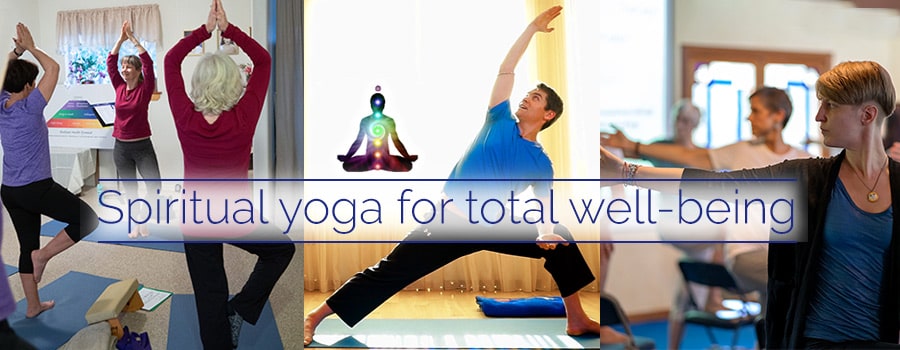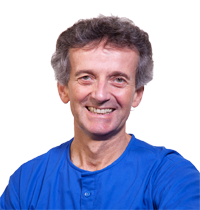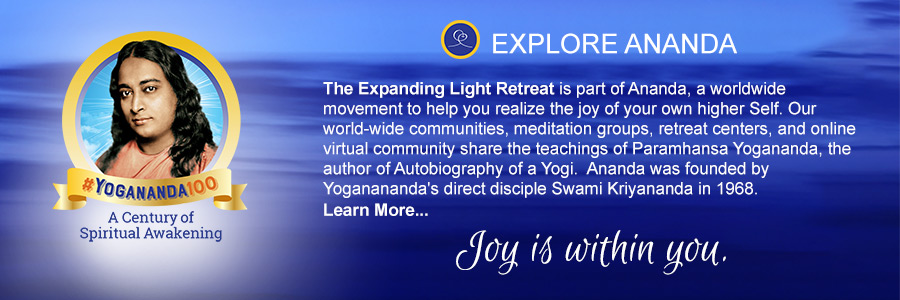Excerpt from
Spiritual Yoga
Awakening to Higher Awareness
by Gyandev McCord
©Hansa Trust
Now Available
Chapter 1
The Art and Science of Hatha Yoga
Yoga is an art as well as a science. It is a science, because it offers practical methods for controlling body and mind, thereby making deep meditation possible. And it is an art, for unless it is practiced intuitively and sensitively it will yield only superficial results.
— Paramhansa Yogananda
Hatha Yoga, like its parent discipline of Raja Yoga, is a science. Why? First, it’s based on universal aspects of human nature. Second, it focuses on direct experience, not on beliefs. Third, anyone who performs the Hatha experiment will receive predictable benefits.
Ah, but how much benefit will you receive, and how quickly? Here’s where the art of Hatha Yoga comes in. As in any field of endeavor, the outward aspects of Hatha practice will, by themselves, bring only limited benefit. Many people know the techniques of artistic painting, for example, yet only those with deep inner understanding of how to apply those techniques can paint on the level of a Michelangelo. In business, the most successful people have an intuitive feel for their products or services, and for the needs of the marketplace. It’s the same in art, sports, science, literature, farming, music — you name it.
Similarly, to receive the most from Hatha Yoga techniques, you need certain inner tools and understanding to work effectively on subtle levels of your being. The practices in this book will help you develop those inner resources. To begin the journey, let’s get more specific about the science of spiritual Hatha Yoga.
1.1 — The Science: Mind-Energy-Body Connection
Every day, you experience part of the scientific basis for Hatha Yoga: your state of mind causes certain movements of energy within your body, and those movements in turn affect your bodily position. It’s simply body language.
For example, disappointment, lethargy, and gloom cause energy to flow downward in the body, away from the brain. That flow in turn influences your posture: you’ll tend to slump, as if closing yourself off from life. The very words you use reflect that downward movement: “I feel down,” or “I feel low,” or “I feel depressed.”
On the other hand, happiness, enthusiasm, and inspiration cause energy to flow upward toward the brain, which then comes alive. You straighten up into an expansive, life-affirming posture. You tend to inhale as if to embrace the world — and you smile. Your words, too, reflect that upward flow: “I feel on top of the world,” or “I’m in high spirits,” or “I’m feeling upbeat.”
You’ve certainly experienced all this, even if you haven’t seen it as a chain of influence: mind affects energy, which in turn affects the body.
The Key Insight
The reverse is also true: through bodily position you can lift energy toward your brain, and that will in turn uplift your state of mind. This simple insight is a cornerstone of Hatha Yoga, and you can easily prove it to yourself:
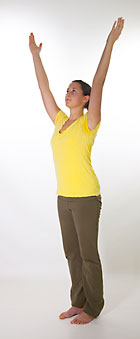
Exercise: On a scale of 1 to 10, rate your current state of mind: 1 is lousy and 10 is terrific. Now set this book aside and stand up.
Stand very erect, with your chest open. Reach your arms overhead, bringing your body into the shape of the letter “Y.” Gaze upward. Reach your entire body upward in the direction of your gaze. Inhale smoothly and deeply, hold your breath, and smile broadly. Stay in this position for a few moments, then exhale with a hearty laugh and relax your arms back down into a normal upright standing position. Breathe naturally.
Now rate your current state of mind once again. I’ll bet that you’ve moved higher up the scale — and if you put a lot of energy into it, maybe off the scale.
Think about it: all you did was make physical movements. This is not rocket science. Quite the contrary: it’s so much a part of us that we usually pay scant attention to it. That’s why we don’t realize its power. Imagine what can happen when you do pay attention to it, and when you add the power of your mind and energy — as you will in later chapters. Fasten your seatbelt!
By the way, you could (although who would want to?) adopt a bodily position that would move you down the scale. All you need to do is slump, exhale strongly, gaze downward, and frown. And if you keep on doing that … well, please don’t.
These are very simple examples of the effect of the body on energy and consciousness. Yoga offers many techniques that use the body to lift energy more powerfully than this — and the more energy you lift, the more you’ll raise your consciousness. As you’ll see in later chapters, each of Hatha Yoga’s many asanas and pranayamas has its own special effect on energy and consciousness. You can weave these techniques into an overall practice that brings abundant, calm, focused energy to the brain. That will uplift your consciousness, preparing you for Yoga’s most powerful tool: meditation.
The Heart Plays a Role, Too
With all the emphasis on bringing energy to the brain, you may wonder, “Does this mean that the heart isn’t important, spiritually?”1 No, the heart is vital, for it guides the process of spiritual unfoldment from beginning to end. The heart is the source of all desire, and spiritual growth begins with the desire for true happiness. The heart is also the seat of intuitive perception, through you will experience the final fulfillment: realization of the Self.
Unfortunately, the heart also presents the biggest spiritual obstacles, for it’s the seat of emotion, attachment, and desires for self-gratification. These tendencies agitate the heart, disrupting our intuitive perception. They can pull energy downward or outward more strongly than the techniques can lift it inward and upward. They can distort the mind’s perceptions, skew decisions, and keep one small and self-centered.
Overcoming these tendencies is the very essence of spiritual growth. As the ancient sage Patanjali writes in his Yoga Sutras, “Yoga is the neutralization of the whirlpools of likes and dislikes [which are centered in the heart].” Another great scripture, the Katha Upanishad, promises, “When all the desires of the heart fall away, the mortal becomes immortal, and attains Spirit.”
How to overcome those tendencies? Certainly not by suppressing them. That would be unhealthy — also futile, says the Bhagavad Gita, Yoga’s foremost scripture. Rather, yogis seek to improve their emotional reactions and release attachments, so as not to reinforce those tendencies. At the same time, they seek to increase, calm, and redirect the energy of the entire body — especially the heart — toward the brain. This raises consciousness and helps lift the heart out of the turmoil of emotion and desire. It also creates in the brain an energy magnet that will help lift even more energy.
Overcoming those tendencies is a big job, and techniques alone aren’t enough. They can, however, greatly aid your efforts if you take your practice beyond its mechanical aspects — into the art of it.
1.2 — The Art: Going Beyond Technique
Although the mind and heart can cause trouble, they also hold keys to a deeper practice, and to a deeper spiritual life generally. For among their many faculties are six that are especially helpful for overcoming the downward or outward pulls on your energy and consciousness. Let’s explore those faculties and practice a simple illustrative exercise for each one.
Willpower
Willpower is the ability to direct energy to achieve a desired goal. Paramhansa Yogananda called it “the dynamo of all our powers.” True willpower is much more than brute force or grim determination. Those attitudes lead to tension, which limits the amount of energy you can muster. Much more is possible. Yogananda declared that in one ounce of your flesh there’s enough energy to light the city of Chicago for a week. (Okay, he said that in the 1940’s, but that’s still a lot of juice!) And the energy of the surrounding cosmos is virtually unlimited.
How to access more energy? View willpower as enthusiastic willingness, which is more powerful than forcefulness because it releases energy blockages, opens you to receive more energy, magnetically attracts energy into your body, and helps you cooperate with a greater reality. It’s a lot more fun, too.
Exercise: Many years ago when I was new to Yoga, I participated in a workday at Ananda Village, the ashram where I now live. It was a very hot day, made hotter by the fact that my job was to carry old, rotten lumber — often crawling with carpenter ants — from a dismantled house, up a steep hillside to a blazing burn pile. I worked determinedly, but by mid-afternoon, I was fading.
Then I noticed that a woman who had the same job as I, yet she still had a spring in her step. I thought, “Hold on! I’m bigger, stronger, and younger than she is — and I’m in better shape, too. Why am I tired and she’s not?”
I observed her for a time, and I could feel that she was practicing willingness, not mere determination. I could also feel that she really had to focus to keep that attitude, but she was doing it. She had decided to enjoy the not-so-pleasant work, and that enjoyment was flooding her with energy.
I gave it a try — and I discovered that it wasn’t hard. It was also a lot more fun.
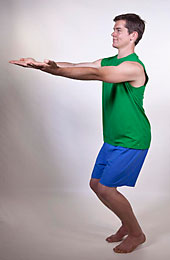
Now for your exercise: Stand up and come onto the balls of your feet, with your arms horizontal in front of you, palms facing up. Bend your knees into a semi-squatting position, as though sitting on the edge of a stool. Keep your torso either vertical or tilted slightly forward from the hips. Breathe naturally and hold this position. When your legs begin to tire, practice your willingness: decide to enjoy being in this position, be enthusiastic about it, look forward to holding it even longer — and watch the energy flood into your body to help you. Fun, huh? Well, it’s fun as long as you’re willing; after that, it’s hard work.
Concentration
Success in anything requires a steady, focused flow of attention and energy toward the task at hand, not giving in to distractions. That’s concentration. Most people view concentration as an act of self-discipline, squeezing one’s attention very narrowly onto some task. That’s a lower form of concentration, because tension is involved, and tension itself will eventually distract you. It’s not much fun, either. There are better ways to stimulate concentration.
One way is to bring energy to the seat of concentration: the forefront of the brain, just interior to the point between the eyebrows. That increased energy will stimulate the faculty of concentration and make it stronger. You can also develop concentration by cultivating interest in the object of your concentration:
Exercise: Sit upright, close your eyes, and begin to watch your breath. That is, feel it and concentrate on it — without controlling it — as it flows in and out through your nose. Don’t analyze it or mentally describe it. Simply watch it. For most people, this isn’t a particularly fascinating thing to do. After a few minutes — or perhaps just a few breaths — your mind might say: “This is boring. I can breathe without paying attention to it. After all, I do it all day, every day. I’ll think about something else instead.” End of concentration.
To stay focused, decide to be interested in the breath, even fascinated by it. Observe it with relaxed yet compelling interest. Be intrigued by the breath without analyzing it. You might have to exert a bit of energy to fuel your interest, and that’s fine. When you have a high level of interest, concentration becomes natural — and much more enjoyable. Decide to be interested.
Feeling
True feeling is not emotion; it’s a direct experience of the essence of something. It’s an intuitive knowing that’s beyond intellect, beyond sensory input — and beyond all doubt. You simply know. We’ve all had that feeling many times, and if you can clearly remember such a time, you’ll recall that the feeling of certainty was centered in your heart, which is the seat of intuitive perception.
Such feelings don’t happen only by chance; intuitive perception can be developed. In fact, it should be developed, for it’s through intuitive perception that you’ll someday know your own soul-essence. You can begin by calmly attuning your heart to whatever you wish to perceive more deeply. It might be a friend’s needs, or a solution to a problem, or how to perform some task. Or as in the following exercise, energy:
Exercise: In this book, I’ll frequently speak of the value of perceiving and controlling energy. If energy seems esoteric, it’s only because it’s so familiar that we don’t notice it, just as we usually don’t notice the air we breathe. With a small shift of attention, it’s easy to feel energy.
Sit or stand upright, arms relaxed at your sides. Inhale deeply, hold your breath and tense your entire body — squeeze hard — then exhale and relax. Do this several times, until you feel calmly energetic. Now you’re on the wavelength of energy, so it’s easier to perceive energy. (Couch potatoes aren’t on that wavelength, so the only energy they’re likely to perceive is the negative energy of resisting activity.)
Close your eyes and turn your attention inward, to the interior of your left arm. With an inhalation, slowly lift your left arm to horizontal in front of you and stretch forward through your fingertips. As you do so, try to perceive — with your heart — the life-force streaming out through the arm to cause the movement. As you slowly exhale and lower the arm, try to feel life-force relaxing back through the arm, away from the fingertips. Repeat this several times. Yes, you’ll also feel such physical sensations as muscles tensing, but try to feel a subtler level beneath the physical. That’s energy. (Chapter 2 offers more exercises to help you perceive energy.)
Visualization
Accomplished yogis consider visualization to be a valuable spiritual tool, and they practice in order to develop it. Picturing something in your mind’s eye is only part of visualization; even more important is to imagine clearly, strongly, and confidently how it will feel, in your heart. In other words, create inwardly the total experience you wish to have. The more vivid and engrossing the inwardly created experience, the more it will support your outward efforts. Visualization is a super-tool, a blend of willpower, concentration, and feeling.
You can use visualization to help control energy, a skill that’s invaluable in many asanas and pranayamas in Ananda Yoga. The next exercise has two parts: you’ll use visualization to help you feel energy, then to control it.
First, some background: As I touched on earlier, when you inhale, energy flows up through the torso — specifically, from the tailbone up to the medulla oblongata (at the base of your brain), then forward and up to the prefrontal lobes of the brain, just interior to the point in the forehead between the eyebrows. As you exhale, energy travels back down that same route. In fact, Yoga teaches that these movements of energy cause inhalation and exhalation. Let’s work with that:
Exercise: Sit upright with your spine straight, close your eyes, and breathe smoothly and deeply.
Part 1 (feeling energy): Your torso tends to straighten up as you inhale, and relax as you exhale. Notice, however, something subtler in the center of your torso: an upward sensation as you inhale, and a downward sensation as you exhale. That’s energy. If you don’t yet feel those sensations clearly, use the torso’s slight physical movements as aids to imagining those sensations. Visualize the currents moving along their path from tailbone to medulla to prefrontal lobes as you inhale, then back down again as you exhale. This harmonizes your attention with the energy currents, making it easier to feel the currents. In addition, you’ve brought your attention into the center of the torso, and energy flows where attention goes. With more energy flowing, you’re more likely to feel it.
Even if you can feel the energy flowing, it’s good to visualize it, because that makes the experience stronger and clearer.
Part 2 (controlling energy): Inhale deeply, then exhale fully so energy returns to the area of the tailbone. Before the body needs to inhale again, strongly visualize energy rising from the tailbone area. Don’t try to inhale; just visualize energy rising. If your visualization is strong enough, energy will indeed rise, causing your body to inhale before it needs to. You’re controlling energy.
Another example: Inhale deeply, then exhale fully so energy returns to the area of the tailbone. Let the body inhale when it needs to, but at the same time, strongly visualize energy flowing downward toward the tailbone. If your visualization is strong enough, energy will indeed go downward, stopping your physical inhalation. Again, you’re controlling energy. Easy! (This exercise is merely to show that you can control energy. Don’t make a habit of blocking your inhalations.)
Positive attitude
These days, everyone knows the psychological value of positive attitude; it also has spiritual value as another super-tool for lifting energy and consciousness, and for countering downward pulls. To practice it, don’t just think about a positive attitude: have that attitude, and express it in everything you do. That’s a good way to strengthen the attitude within you. Here’s another way:
Exercise: In Ananda Yoga, each asana is accompanied by an affirmation that reinforces and amplifies a specific positive attitude that the bodily posture can promote. Repeat the affirmation multiple times as you hold the asana, going deeper and deeper into that positive attitude. This is not only an enjoyable experience; it also gives you valuable support for having — and holding onto — that attitude.

With this in mind, let’s revisit the exercise for willingness: stand up, come onto the balls of your feet with arms extended in front of you, and enter the semi-squatting position. This is the first phase of Utkatasana (Chair Pose), the affirmation for which is, “My body is no burden, it is light as air.” Repeat the affirmation mentally, over and over, with enthusiastic conviction.
Through the affirmation, try to connect with the light-as-air energy reality of your body, rather than feeling the body only as flesh and bones. Absorb yourself in that freedom from bondage to gravity — not only the body’s freedom from physical gravity, but also your mind’s freedom from all heaviness, lethargy, and inertia.
Devotion
Devotion is not sentiment or wishful thinking; it’s your hunger for truth, your heartfelt commitment to your highest aspirations, the vital fuel for your inner growth. Devotion is your spiritual want-power, and like all desire, it’s centered in the heart. Devotion will sweeten your spiritual life and help your energy and awareness rise naturally. Try to infuse it into each of the other five faculties: willpower, concentration, feeling, visualization, and positive attitude. Then your efforts will be augmented by the unlimited power of the heart.
How to make that practical? Devotion is not just a reason for practicing; rather let it guide how you practice. Bring your want-power into your practice of each technique — not in the sense of “Oh I wish …,” but with a sense of that both your longing and your practice are loving connections with the Divine. The mechanics of a technique can sometimes distract you from that focus; keep coming back to it.
Exercise: Sit upright and close your eyes. Feel your heart’s desire to realize your highest spiritual aspiration. Strongly offer that desire upward, so that your heart surges upward. Keep feeling that upward surge as you begin to watch the breath, just as you did in the visualization exercise.
Be deeply interested in the breath — not mere curiosity, but an interest born of knowing that you can experience the Divine if you’re still enough and listen sensitively enough. Make watching the breath a loving invitation to your Higher Power. Such devotion-driven interest deepens your concentration and infuses any technique — asana, pranayama, meditation — with the unlimited power of your heart.
• • •
The bottom line: although methodical, scientific efforts alone can raise our awareness somewhat, we can do much more if we bring these six faculties skillfully into the practice. Then Hatha Yoga comes into its own as a tool for spiritual growth.
Different faculties will be more relevant at different times. Learning to apply them is part of the art of spiritual Hatha Yoga. This process is creative, it’s fun, it’s rewarding, and anyone can do it. Although no one can show you how to apply these faculties, I hope that the above exercises will give you some ideas. Chapters 4, 5, and 6 offer many more tips to help you develop your own inner understanding of this art.
In most people, these faculties need some training in order to be effective, and as you’ll see, Ananda Yoga is an ideal training ground. When you apply these faculties in your practice, you’ll not only deepen your practice, but also develop a unique, personal understanding of how to apply them effectively throughout your life. And the more you apply them, the stronger they’ll become.
1.3 — The Highest Art
Everything so far — both science and art — has been about self-effort. That’s essential, and it can accomplish much: relaxation, clarity of mind, vitality, healing, wellness, and a good bit of consciousness-raising. But if you want the highest from Yoga, there’s another important factor to consider. I’ll tell you a true story:
Some years ago, a certain master teacher was with a group of his students, one of whom was accomplished in the asanas — and rather proud of it.
Sensing this, the teacher asked him, “Can you do the Half Lotus Pose?”
“Yes, sir,” the student replied, and he immediately went into the asana.
“Very good,” said the teacher. “Can you do the Full Lotus Pose?”
Trying to appear humble, but in fact being rather proud of his ability, the student performed the asana.
“Excellent,” smiled the teacher. “Next, grasp your hair firmly with one hand.”
Expectantly, the student did so.
“Now,” said the teacher, “pull yourself up off the floor.”
The student immediately got the point, and was humbled.
The teacher’s point was that while self-effort can accomplish much, it cannot by itself bring Self-realization. You can’t lift yourself by your own bootstraps — or hair. As so many great spiritual traditions affirm, divine grace is needed. Swami Kriyananda puts it this way:
Yogis of both the Hatha and Raja Yoga schools often make the mistake of thinking that spiritual enlightenment depends only upon the efforts of the aspiring devotee — as if by techniques alone one could harness the Infinite! A right understanding of the yoga techniques, however, in no way contradicts the need for kripa (divine grace), as the sine qua non of the spiritual path.
The good news is, divine grace is always at hand. If it seems absent, that’s only because the mind and heart are agitated and distracted. In seeking outward fulfillment, we overlook the greater fulfillment that can come from within. Yoga techniques can calm that agitation and, when guided by our sincere aspirations, help redirect heart and mind inward and upward. The calmer, more positive, and more uplifted we become, the more we’re on the wavelength of Spirit, so that divine grace can flow more abundantly into our lives. Grace can come in many forms: It can come as an unseen boost to our own efforts, or as the removal of an obstacle. It also can come as a release from an attitude that has held us back. Or it can come as a resolution of a difficult situation, or at least a much-needed change of perception about the situation.
So practice with Spirit. Try to feel Him or Her (or It, or your Higher Self) with you throughout your practice. If you don’t feel that presence, imagine how it would feel. Ask God to show you how to practice, then try to feel any guidance that comes. In fact, try to feel God with you throughout your entire life. Create a divine partnership — in your own way, through your own unique relationship with, and understanding of, the Divine Friend. This is the highest and most rewarding art of all. There’s no limit to what you and the Infinite, working together, can do.
• • •
A right balance between science and art, and between self-effort and grace, along with a living relationship with Spirit — these are central to a spiritual approach to Hatha Yoga. There’s no secret formula for the right balance; it’s highly individual. You’ll find it through your own experimentation — and as you do, a new world of joy-filled possibilities will open to you.
Meanwhile, prime the pump for that outpouring of joy: as you practice, be sure to have fun!
1 In this book, “heart” always refers to a chakra (energy center) located near the physical heart. For now, think of “brain” as another energy center, located in the physical brain. As Chapter 2 explains, however, the physical brain corresponds to more than one chakra. Back to text
©Hansa Trust
Learn More About Ananda Yoga
- Find a certified Ananda Yoga teacher near you
- Read about Ananda Yoga Teacher Training programs
For more information, please send us a Question or Comment:
All authors are graduates of Ananda Yoga Teacher Training.



